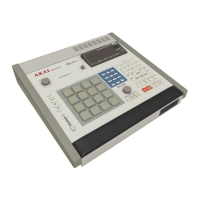tempo change with a value of 50% at bar 5 (120 BPM X 50% = 60 BPM).
To delete the currently displayed tempo change, press the <Delete> soft key.
The field at the top of the screen, TEMPO CHANGES, is a choice field with
2 options: ON and OFF. If set to ON, tempo changes are used; if set to OFF,
all tempo changes within the sequence are ignored.
3.9.3 The TAP TEMPO key
The TAP TEMPO key allows the tempo to be quickly set by tapping 2 beats (1/4
notes) on the TAP TEMPO key. After two taps, the MPC60 automatically
assumes the two taps to be 1/4 notes and recalculates a new tempo to match those
1/4 notes.
For example, to quickly change to a tempo of 80 BPM, tap two 1/4 notes at a
tempo of approximately 80 BPM on the TAP TEMPO key. After the second tap,
the new tempo will appear in the TMPO field of the main PLAY/RECORD
screen. This may also be done while the sequence is playing.
Normally, only two taps are required before the MPC60 recalculates the new
tempo. However, it is possible to set this feature so that it recalculates the tempo
by averaging the last 3 (or 4) successive tap intervals. This is set in the TAP
AVERAGING field, located in the TEMPO screen, and is explained further in
that section of the manual.
3.9.4 Sequencer speed limitations at fast tempos
If many notes exist at exactly the same location within a sequence and that
sequence is played at a fast tempo, some of the notes may be slightly delayed
when played back. For example, if 20 notes all play exactly at position 002.01.00
within the sequence and the playing tempo is 200 BPM, some of these 20 notes
occurring at the same time may be delayed as much as 10 to 20 milliseconds
when played back. This condition exists to some degree in all sequencers, and is
due to the fact that there is a finite number of notes which the internal computer
can process at one time. However, this will NOT cause the
66

